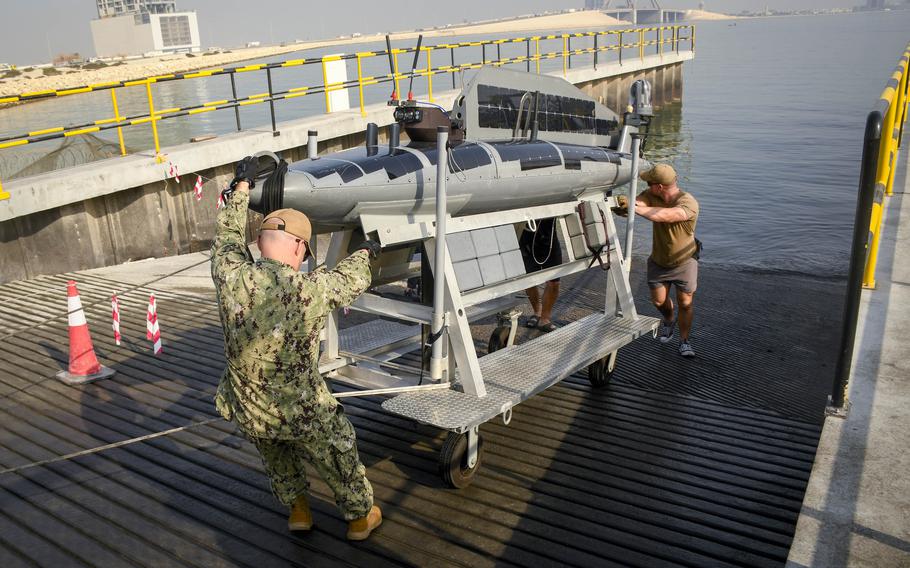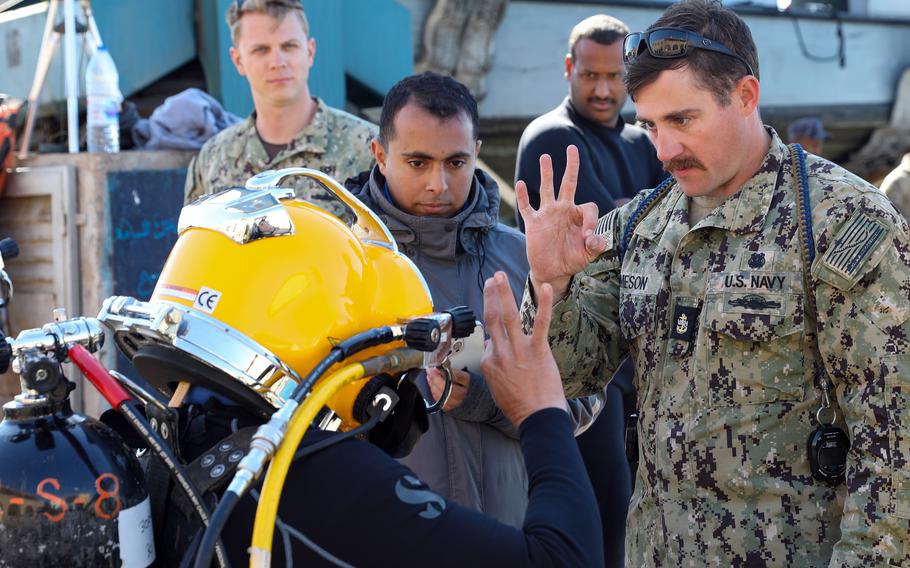
Sailors with the Navy’s Task Force 59 launch a drone boat from a pier at Naval Support Activity Bahrain in 2022. The recent U.S.-led IMX 25 exercise in the Middle East focused on advancing artificial intelligence and unmanned systems as the Navy and its regional partners adapt to evolving threats in the region. (Stars and Stripes)
MANAMA, Bahrain — A recent U.S.-led maritime exercise in the Middle East shifted its focus to building artificial intelligence and drone capabilities as the Navy and its partners work to address increasingly sophisticated threats in the region.
The emphasis represents a change at this year’s International Maritime Exercise, which normally focuses on mines and explosive ordnance disposal, among other training.
It also comes as the Navy and other nations in the region prioritize adaptation to technology used by Iran and its proxies in Lebanon, Yemen and other countries, service officials say.
For example, Iran-backed Houthi militants in Yemen have launched swarm drone attacks against ships in the Red Sea in the past year.
The U.S. and its partner navies in the region also are defending against cyberattacks on their systems, Vice Adm. George Wikoff, commander of U.S. Naval Forces Central Command/U.S. 5th Fleet, said Thursday.
“Cyberattacks are a great example of where AI can make a real impact,” Wikoff said, adding that it has “great promise” as a cyber protection tool.
AI also is becoming a bigger factor in stopping adversaries, Wikoff said.
Information picked up by Navy sensors in the sea regarding such activity as drug or weapons smuggling can be evaluated more efficiently using AI, which allows a better understanding of what is happening in regional waterways, he said.
“Our ability to get through that data and find what’s really important is always a challenge, and AI is helping accelerate that,” Wikoff said.
He noted that Task Force 59, a Bahrain-based unit focused on testing and deploying drones and using AI, has played an important role in leading Navy security efforts at sea.
Wikoff made the comments as the 12-day IMX25 ended Thursday. The exercise also included noncombatant evacuation, search and seizure, vessel defense, search and rescue, and mass casualty response, the Navy said.
It was linked to Cutlass Express, an exercise in eastern and southern Africa led by U.S. Naval Forces Europe-Africa. Together, there were about 30 countries and 5,000 personnel participating in the exercises, the Navy said.
The maritime portions took place in the Persian Gulf, Arabian Sea, Gulf of Oman, Red Sea and northern Indian Ocean.
“If you look around the room today, you’ll see naval personnel from every continent on the Earth with the exception of Antarctica,” Wikoff said during the exercise’s closing ceremony.
This year’s IMX took place during a period of relative calm in the region. That is chiefly due to the Houthi militants’ stoppage of their attacks on ships in the Red Sea because of a ceasefire reached between Israel and Hamas in Gaza last month.
Even so, there were about 50% fewer participants in the exercise than in previous years, Navy officials noted. In 2022, about 60 nations participated, they said.
Wikoff attributed the drop to the fact that navies are stretched by multiple global obligations, adding that participant numbers aren’t the sole factor determining success.
“It’s about the quality of the training and (whether) those that participate ... get what they want out of it,” Wikoff said.

Chief Petty Officer Davin James, right, provides instructions to Jordanian navy 1st Sgt. Mohammed Alqeesy before a dive during International Maritime Exercise 25 in Aqaba, Jordan, Feb. 13, 2025. This year's exercise also focused on unmanned warfare and artificial intelligence. (Arif Patani/U.S. Navy)